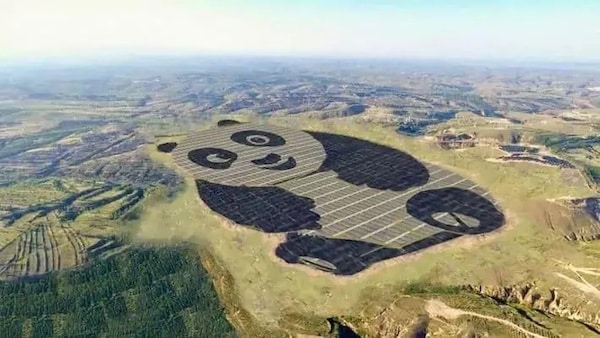It’s so fitting that just after the 75th anniversary of China’s revolution on Oct. 1, a milestone in China’s efforts to deal with greenhouse gas emissions (GHGs) has emerged in the narrative surrounding global warming. What they have accomplished shows how people’s ownership of the world’s productive forces, instead of a tiny clique of billionaires owning everything, will solve this planetary crisis.
Climatologists and scientists widely recognize that China will likely reach its peak greenhouse gas emissions in 2024, although further research will be needed to confirm this with complete accuracy. If the data ultimately shows that the peak does not occur in 2024, it is almost certain to happen in 2025. Even in that case, China would still achieve peak emissions five years earlier than its official target, which President Xi Jinping announced at the 2020 UN General Assembly. This target aimed to reach peak emissions by 2030.
Other countries have reached peak emissions as well, but because China is so huge, UN figures and climatologists are buzzing with excitement over this development. It has great implications for the entire world, particularly for the Global South.
U.S. corporate media often portray China’s crowning achievement as a problem rather than progress.
Mass production of renewables
Chinese mass production of renewable energy components–wind and solar–has driven down the prices globally. It isn’t just the solar panels on rooftops that millions are aware of; China has developed renewables on an industrial scale–wind and solar farms built at much lower costs and capable of supplying energy for cities and industry.
What this means to the Global South cannot be overstated. For instance, a struggling country in Africa, Latin America, or Asia relying on coal for energy can now replace a decrepit coal-fired power plant with a solar or wind farm more cheaply than repairing or replacing that coal plant.
The flaw of wind and solar power’s intermittent availability is still there. China is still running coal plants in its territory as a backup for those times when the sun goes down, or the wind stops.
On average, Chinese coal plants run half the time or less. This simple first step provided what seems to be an outsized result, and it can be replicated where it is needed in the Global South until the intermittency problem with renewables is resolved via other methods.
Control over the means of production
The Communist Party of China faces a real challenge–trying to balance raising and safeguarding the living standards of 1.4 billion people while still developing its scientific and productive capacities and combating climate change at the same time.
China’s capacity to overcome significant challenges stems from the people’s control over the means of production.
When the world’s manufacturing shifted to China in 1979, private interests began to invest in mines and other power generation sources. But that didn’t last long because the CPC and the government recognized that energy has to belong to the people, and they began nationalizing the mines. That process began in the 1980s, and now the number of mines in private hands is insignificant, and they are the smallest, least productive mines.
Inexpensive EVs
Chinese mass production of inexpensive electric vehicles has also been a factor in moving forward in the campaign to lower GHG (greenhouse gas) emissions. Millions of workers in China can now afford the price of a car, not only because 850 million people have been lifted out of extreme poverty but also because China has wonderful, inexpensive electric cars.
Over the past decade, the Chinese state has spent $230 billion on research and development of EVs and batteries. China’s spectacular success in producing electric vehicles has prevented a surge in emissions from the increased use of cars.
Some of China’s EVs sell for as little as 10,000 U.S. dollars. They are getting rave reviews and are being sold in Southeast Asia, Latin America, Africa, and Europe.
The Biden/Trump tariffs make buying one in the U.S. difficult, but the no-emissions cars are now helping to cut emissions throughout the rest of the world. The sales and use of EVs in China’s territory alone are a significant factor in reducing the world’s GHG emissions.
Beyond cars, the shift to electric power for trucks and trains, both passenger and freight, has been crucial in curbing emissions and achieving peak emissions goals.
Environmental protection in the constitution
The Communist Party of China has taken the significant step of incorporating environmental protection into both its party constitution and the constitution of the People’s Republic of China.
The leadership of the CPC and the Chinese state do not face opposition from super-rich monopoly corporations. Still, this achievement of reaching peak emissions doesn’t mean that reaching “net zero” by the year 2060 will proceed in a straight line.
Like many developing countries, China is still struggling to overcome what it calls the “century of humiliation,” when imperialist Western countries robbed China of its resources and used their military advantage to enforce the theft. The 1949 revolution was only the first step, and it still faces challenges.
In the short term, China needs to develop AI, which will require a lot of electrical energy. Their goal is to power AI with renewables.
They are also investing in research and development of many projects, ranging from areas that seem nearly ready to use, like green hydrogen as fuel whose only by-product is water, to their “artificial sun,” China’s fusion energy project. All of this is being implemented and studied while also trying to help develop the resources for global south countries to mitigate global warming and help them adapt to climate change.
2024 will prove to be the hottest year on record globally. Alongside the horrors of the genocide in Gaza and the U.S. proxy war against Russia, capitalism has dished out the most punishment of the planet in recent memory. Only socialism can end imperialist war and save the planet.

